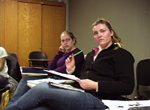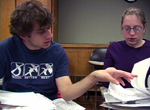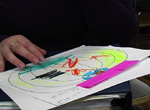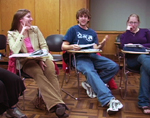
BEGINNING THE JOURNEY FROM STUDENT TO TEACHER
Sharon Feiman-Nemser • Brandeis University, Waltham, MA • Foundational Skills and Dispositions in Teaching
|
|
Analyzing Student Work |
|||||||||||
As part of their child study, students bring in a sample of work – typically a piece of writing or a drawing -- from their study child. This enables us to practice describing what we see in the work as evidence of what the child can do rather than jumping quickly to evaluating what the child cannot do. I am also hoping that the close study of a piece of work will provide a basis for speculating about the child as a learner, even a writer or artist. I have students work in pairs, exchanging their artifact with their partner and using a variation on a “collaborative assessment” protocol to examine each piece of work. One limitation is that students do not always know what assignment prompted the work they have collected. I also use this occasion to introduce literacy standards for grades K-3 developed by the National Center for Excellence in Education at the University of Pittsburgh which come with samples of student writing, rubrics and analyses and to show students the Massachusetts’ language arts standards. My goal here is to give students some language and frameworks for looking at student writing so that they notice voice, dialogue, descriptive detail not only spelling and punctuation. |
|||||||||||
|
|
||||||||||
To provide feedback, email us at questfeedback@carnegiefoundation.org



